

 |
The Sixth International Conference on Digital Society ICDS 2012 January 30 - February 4, 2012 - Valencia, Spain |
|
|||||||||||||||
| Details: |
ISBN: 978-1-61208-176-2 |
|
||||||||||||||||
All tracks/topics are open to both research and industry contributions.
Tracks:
Citizen-centric disruptive and enabling technologies
Wireless and user mobility; Ubiquitous systems; On-line interactions; User-centric services, applications, eLearning; High speed electronics, storage, networking eHealth and nano medicine; Biological informatics and computing
Internet and Web services
IP-based networking and applications; Best effort and QoS/SLA; WWW, Web Services, Semantic Web; eLearning and mobile learning; Service-oriented platforms; Peer-to-Peer Systems and applications; Web-advertising and Web-publishing Multimedia and Webcasting
eGovernment services in the context of digital society
e-Government strategies; Citizen-Government eModels; Special applications and services of eGovernment; ePayment, eTax administration; eVoting, eCitizen identity cards; Social e-financial projects; Educating eHealth; Homeland security and public records; eGarbage collection of private records; Metrics for eGovernment projects and services; Benefits of eGovernment; On-line social networking; Financing e-Government
e-Governance; From e-Government to m-Government (mobile-Governemet); e-Environment
eCommerce and eBusiness
On-line shopping frameworks; Trust, privacy, security; Internet macro and micro payment systems; On-line banking; Agent-based e-commerce; eBusiness models and costs; eBusiness applications; Infrastructure for e-Commerce; Mobile commerce
Citizen-oriented digital evidence
Processing citizen-oriented electronic evidence (acquisition, preservation, analysis); Multimedia documents ( X-rays, radiology, biometrics, and surveillance data); Medical digital forensics; Classic and 3D medical documents; DNA profiling; Genetic and biocomputing; Forensic and data mining; Predictive data modeling; Biological data and privacy; Digital forensics tools
Consumer-oriented devices and services
Mobile TV and IPTV; Consumer-oriented e-commerce; Smart and digital homes; Wearable devices; Smart consumer appliances; Speech enable appliances; Consumer accessibility appliances and services
Intelligent computation
Theories of agency and autonomy; Intelligent techniques, logics, and systems; Evolutionary computation; Autonomic and autonomous systems; Autonomic computing and autonomic networking; Ubiquitous and ambient computing; Computational economics; Protecting and preventing computing; High performance computing; Service-oriented computing; Multi-agent based computing; Cluster computing and performance; Artificial intelligence
Networking and telecommunications
Networking and telecommunications technologies; Wireless, mobility and multimedia systems; Internet and Web Services technologies; Systems performance, security, and high availability; Communications protocols (SIP/H323/MPLS/IP); Specialized networks (GRID/P2P/Overlay/Ad hoc/Sensor); Advanced services (VoIP/IPTV/Video-on-Demand); Advanced paradigms (SOA/WS/on-demand)
eDefense for security and protection
Knowledge for global defense; Security in network, systems, and applications; Trust, privacy, and safeness; Business continuity and availability; Cryptography and algorithms encryption; Rapid Internet attacks and network; Applications and network vulnerabilities
Intrusion Prevention and Detection Systems
Reducing false positives and improving true positives; Automating IPDS responses; Innovative signature writing and processing; Improving IPDS usability; Successful approaches to Anomaly IPDS (Statistical; Fuzzy logic; Bayesian; Neural networks, etc.); Inventive behavioural based IPDS methods; Inventive host based IPDS methods; Improving the performance of IPDS; Multiple sensor IPDS; Tuning IPDS; The business cases supporting IPDS; Network traffic normalization techniques; Cost/Benefit of IPDS; Combining IPDS with other hardware e.g. firewalls, routers etc.; Inventive methods of using IPDS to counter specific attack types (Web attacks; Buffer overflow attacks; Brute force attacks, etc.); Comparisons of different IPDS mechanisms; Combining multiple IPDS approaches
Enforced citizen-centric paradigms
Data-centered information systems; User-centric information systems; Pervasive and ubiquitous systems; Mobile learning and communications; Open and distance education systems
Computational advertising
Computational linguistics; Linguistic signal processing; Statistical properties of community structures; Semantic contextual advertising; Relevance and click feedback; Searching dense and isolated submarkets; Latent factor models; Semantic relatedness; Personalized ad delivery; Processing over query-dependent functions; Inverse document frequency; Query-biased summarization; Pseudo-relevance feedback; Classification of rare queries; Page ranking
Management and control
Digital telecommunications management; Control and monitoring systems; Measurement and management systems; Human/Machine interface and man-in-the-loop control; Energy and power systems control; Self-monitoring, self-diagnosing, self-management systems
Digital analysis and processing
Digital information processing (Voice/Data/Video); Computer graphics and animation; Virtual reality/3D graphics/Games; Computer modeling/simulation; Graphic/Image/Photo/Hand-writing analysis and processing; Pattern recognition / Computer vision; Natural language processing / robust processing; Speech recognition and processing
Mobile devices and biotechnologies
Robotics/Mobile devices/ Mobile networks; Handled and wearable computing and devices; Vehicular navigation and control; Nanotechnologies/Systems-on-the-chip/Networks-on-the-chip/ Haptic phenomena; Biotechnologies/Bioinformatics/Biometrics/Biomedical systems; Computational biochemistry; Biological data management
Software and system robustness for digital society
Portals and user-oriented systems; Software as a service; Software specification and design methodologies; Software development and deployment; Programming languages and supporting tools; Patterns/Anti-patterns/Artifacts/Frameworks; Agile/Generic/Agent-oriented programming; Neuronal networks/Fuzzy logic/Temporal logic/ Genetic Algorithms; Reasoning models/Model checking/Modular reasoning/; Program verification/validation/correctness ; Embedded and real-time systems;
Consumer-oriented digital design
Online consumer decision support & advertising; Semiotic engineering of online services; Human factors in computer systems; Personal information management; Consumer trust in digital society; Interaction in smart environments; Mobile consumers and interactive spaces; Hedonic and perceived digital quality; Usability, aesthetics, and accessibility; Multimodal and interactive interfaces; Intelligent user interfaces
Social networking
Social networking technologies (Web 2.0, faceBook, YouTube, Twitter, etc.); Enterprise social networking; General informative webcast; Government information webcast; State-of-the-art for chat, blogs, wikis, etc.; Text-audio-video blogs; Virtual tradeshows; Social profiling; Contextual social network analysis; Personalization for search and for social interaction; Dynamics, evolution, and trend prediction patterns; Social interactions; Medical assistance in social networking; Data protection inside communities; Misbehavior detection in communities; Pattern presentation for end-users and experts; Evolution of communities in the Web; Online and offline social networks; Information acquisition and establishment of social relations
ICT support and applications for eCollaboration
Touch screen voting; Local e-Participation; Portals and eGovernment websites; eGovernment platforms and benchmarks; Business process management; Interoperable frameworks (national and cross-countries); Private-public eCollaboration; Regional and cross-nation competitiveness







